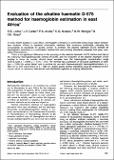Evaluation of the Alkaline Haematin D-575 Method for Haemoglobin Estimation in East Africa
View/
Publication Date
1994views
downloads
Metadata
Show full item recordCitation
Lema OE, Carter JY, Arube PA, Munafu CG, Wangai MW, Rees PH. Evaluation of the alkaline haematin D-575 method for haemoglobin estimation in east Africa. Bull World Health Organ. 1994;72(6):937-41. PMID: 7867140; PMCID: PMC2486729.
Abstract/
In many health facilities in east Africa, haemoglobin estimation is performed using visual colour comparison methods. Efforts to establish colorimetric methods face numerous constraints, including the unavailability of standards for quality control. In contrast, the alkaline haematin D-575 method for haemoglobin estimation is a colorimetric method that uses primary standards prepared from pure, crystalline chlorohaemin. There is no significant difference in the accuracy of the alkaline haematin D-575 method and that of the reference haemiglobincyanide method (P > 0.05), and the response of the alkaline haematin D-575 method is linear for serially diluted blood samples over the haemoglobin concentration range 19.6-3.3 g/dl (r = 0.994, y = 1.01 x - 0.3). The method has a precision of +/-0.3 g/dl (coefficient of variation = (1.8%) for whole blood, and is suitable for use with fixed-wavelength haemglobinometers (lambda = 565 nm) or with colorimeters at lambda = 580 nm. Stable quality control standards could be prepared at provincial, zonal, or reference laboratories and distributed regularly to outlying laboratories.
Further Details
Bulletin of the World Health Organization, 1994
Publisher
World Health OrganizationCollections
- General - GEN [367]

